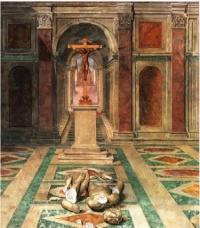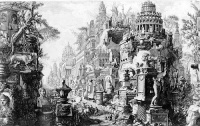Europe
From The Art and Popular Culture Encyclopedia
| Revision as of 09:33, 6 October 2013 Jahsonic (Talk | contribs) ← Previous diff |
Revision as of 09:34, 6 October 2013 Jahsonic (Talk | contribs) Next diff → |
||
| Line 1: | Line 1: | ||
| + | [[Image:Tommaso.Laureti.Triumph.of.Christianity.jpg|right|thumb|200px|''[[Triumph of Christianity]]'' by [[Tommaso Laureti]] (1530-1602), ceiling painting in the [[Sala di Constantino]], [[Apostolic Palace|Vatican Palace]]. Images like this one celebrate the destruction of ancient [[Paganism|pagan]] culture and the victory of [[Christianity]].]] | ||
| + | [[Image:Nicolas Ledoux.jpg|thumb|200px|[[Théatre de Besançon]], interior view by [[Claude Nicolas Ledoux]] ]] | ||
| [[Image:Paris at the 1900 World Fair.jpg|thumb|right|200px|[[Paris]] at the [[1900]] [[World's Fair]]: [[Exposition Universelle (1900)|Exposition Universelle]]]][[Image:Antichità Romane.jpg|thumb|right|200px|This page '''{{PAGENAME}}''' is part of the [[Ancient Rome]] series. | [[Image:Paris at the 1900 World Fair.jpg|thumb|right|200px|[[Paris]] at the [[1900]] [[World's Fair]]: [[Exposition Universelle (1900)|Exposition Universelle]]]][[Image:Antichità Romane.jpg|thumb|right|200px|This page '''{{PAGENAME}}''' is part of the [[Ancient Rome]] series. | ||
| <br>Illustration: ''[[Antichita Romanae]]'' ([[1748]]) by [[Giovanni Battista Piranesi|Piranesi]]]] | <br>Illustration: ''[[Antichita Romanae]]'' ([[1748]]) by [[Giovanni Battista Piranesi|Piranesi]]]] | ||
| Line 16: | Line 18: | ||
| :''[[European culture]], [[Dead white European males]] - [[Eurocentrism]] - [[European culture]] - [[continental philosophy]]'' | :''[[European culture]], [[Dead white European males]] - [[Eurocentrism]] - [[European culture]] - [[continental philosophy]]'' | ||
| ===Overview=== | ===Overview=== | ||
| - | [[Image:Tommaso.Laureti.Triumph.of.Christianity.jpg|right|thumb|200px|''[[Triumph of Christianity]]'' by [[Tommaso Laureti]] (1530-1602), ceiling painting in the [[Sala di Constantino]], [[Apostolic Palace|Vatican Palace]]. Images like this one celebrate the destruction of ancient [[Paganism|pagan]] culture and the victory of [[Christianity]].]] | + | :''[[Western culture]], [[European tourism]]'' |
| - | [[Image:Nicolas Ledoux.jpg|thumb|200px|[[Théatre de Besançon]], interior view by [[Claude Nicolas Ledoux]] ]] | + | |
| - | {{Template}} | + | |
| - | :''[[Europe]], [[culture]], [[Western culture]], [[European tourism]]'' | + | |
| The '''culture of [[Europe]]''' might better be described as a series of multiple cultures, often competing; geographical regions opposing one another, [[Orthodoxy]] as opposed to [[Catholicism]] as opposed to [[Protestantism]] as opposed to [[Judaism]] as opposed to [[Secularism]] as opposed to [[Islam]]; many have claimed to identify cultural [[fault line]]s across the continent. There are many cultural [[innovation]]s and movements, often at odds with each other, such as Christian proselytism or [[Humanism]]. Thus the question of "common culture" or "common values" is far more complex than it seems to be. | The '''culture of [[Europe]]''' might better be described as a series of multiple cultures, often competing; geographical regions opposing one another, [[Orthodoxy]] as opposed to [[Catholicism]] as opposed to [[Protestantism]] as opposed to [[Judaism]] as opposed to [[Secularism]] as opposed to [[Islam]]; many have claimed to identify cultural [[fault line]]s across the continent. There are many cultural [[innovation]]s and movements, often at odds with each other, such as Christian proselytism or [[Humanism]]. Thus the question of "common culture" or "common values" is far more complex than it seems to be. | ||
Revision as of 09:34, 6 October 2013


Illustration: Antichita Romanae (1748) by Piranesi
|
Related e |
|
Featured: |
- “Heaven is where the police are British, the cooks are French, the mechanics are German, the lovers are Italian and the bankers are Swiss. Hell is where the police are German, the cooks are English, the mechanics are French, the lovers are Swiss, and the Italians the bankers”.
Europe is one of the world's seven continents.
Europe, in particular Ancient Greece, is the birthplace of Western culture. It played a predominant role in global affairs from the 16th century onwards, especially after the beginning of colonialism. Between the 16th and 20th centuries, European nations controlled at various times the Americas, most of Africa, Oceania, and large portions of Asia. Both World Wars were largely focused upon Europe, greatly contributing to a decline in Western European dominance in world affairs by the mid-20th century as the United States and Soviet Union took prominence.
Contents |
Culture
- European culture, Dead white European males - Eurocentrism - European culture - continental philosophy
Overview
The culture of Europe might better be described as a series of multiple cultures, often competing; geographical regions opposing one another, Orthodoxy as opposed to Catholicism as opposed to Protestantism as opposed to Judaism as opposed to Secularism as opposed to Islam; many have claimed to identify cultural fault lines across the continent. There are many cultural innovations and movements, often at odds with each other, such as Christian proselytism or Humanism. Thus the question of "common culture" or "common values" is far more complex than it seems to be.
Upon the pagan cultures of aboriginal Europe, the foundations of modern European cultures were laid by the Greeks, strengthened by the Romans, stabilized by Christianity, added to by the rest of Europe, reformed and modernized by the fifteenth-century Renaissance and Reformation, and globalized by successive European empires between the sixteenth and twentieth centuries. Thus the European Culture developed into a very complex phenomenon of wider range of philosophy, Judeo-Christian and secular humanism, rational ways of life and logical thinking developed through a long age of change and formation with the experiments of enlightenment, naturalism, romanticism, science, democracy, fascism, communism, and socialism. Because of its global connection, the European culture grew with an all-inclusive urge to adopt, adapt and ultimately influence other trends of culture. As a matter of fact, therefore, from the middle of the nineteenth century with the expansion of European education and the spread of Christianity, European culture and way of life, to a great extent, turned into "global culture," if anything has to be so named.
By medium
European cinema, European music, European art
By genre
Euro trash - European comics - European disco - European erotica - European exploitation (culture) - European horror
See also
- European stereotypes
- European wars
- United States of Europe
- A French satirical cartoon map of Europe in 1870


_-_B._Bellotto.jpg)


